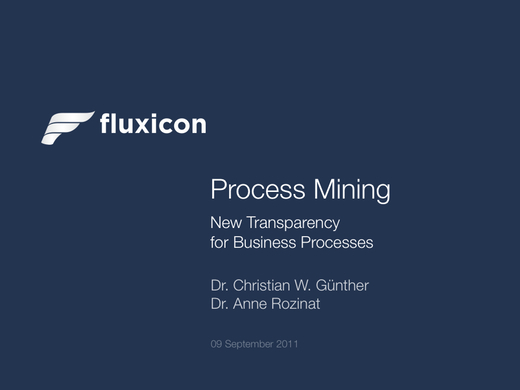Process Mining in Pecha Kucha Format
A bit more than one month ago, we were invited to give a talk about process mining at the BPMCon 2011 in Berlin1. The conference organizer Camunda decided that the presentations were to be held in so-called Pecha Kucha format. The rules of a Pecha Kucha talk are simple:
- 20 slides
- 20 seconds for each slide
- slides advance automatically
This presentation format is quite a challenge, but Christian made beautiful slides and it was really fun to deliver our process mining talk this way.
Pecha Kucha is great for the audience, because it is short. It is also good for the speaker, because one has to be well-prepared and really compact. In my view, more presentations should be like this.
So, here is how we presented process mining in 6 min and 40 seconds. Imagine yourself in the audience, and you’ll see it’s quite entertaining!
1. Process mining – New transparency for business processes
![]()
Hi, I am Anne Rozinat from Fluxicon, and I want to talk about Process Mining. Process mining is a new technology that helps to make business processes visible. What that exactly means, and why it’s important, I want to show you in the coming 6-7 minutes.
2. Mismatch between ideal world and reality
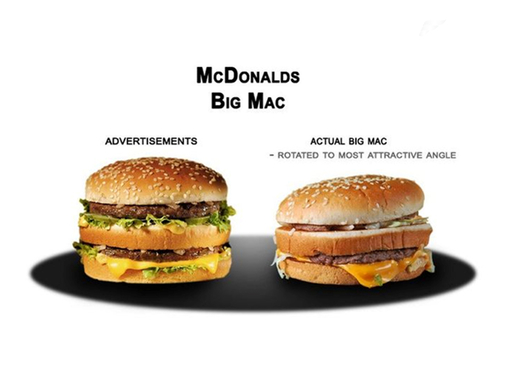
The ideal world and reality often differ, they don’t match. That’s also the case for business processes. The true business processes are usually much more complex and not as simple and structured as the documented or ideal ones. But also the way people think about processes and the reality are quite different,
3. Also true for business processes
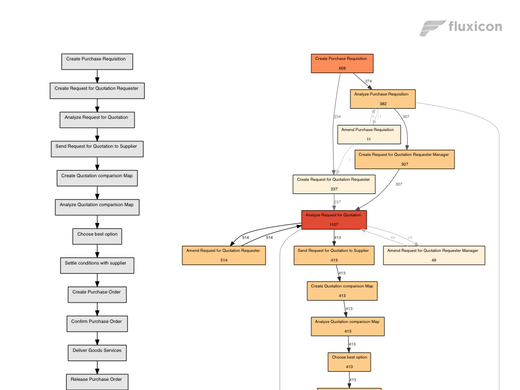
… which you can see here in this example of a purchasing process, which on the left has been described by an employee of the company as very simple and linear. On the right you see the actual purchasing process as we could reconstruct it using our process mining tools. As you can see, the real process is much more complicated.
4. Wrong information leads to wrong decisions

The problem with that is that wrong information leads to wrong decisions. You need to have a very good understanding of what is going on and how your processes look like to be able to control and improve them. So, this lack of information is a really critical problem for the business.
5. One of the reasons: Exceptions

Now, where do these differences come from? First of all, processes change. They change all the time. And secondly, there are all kinds of exceptions that need to be handled in real life in order to operate the process properly. These exceptions lead to deviations from the nicely documented processes.
6. Second reason: Everyone sees only a part of the process

A second reason is that everyone only sees a small part of the process. Often, people have no idea what exactly is happening before and afterwards in the same process. So, it is difficult to get a complete picture of what is going on. Nobody has a complete overview of the end-to-end process.
7. Third reason: Processes are just very complex

And finally, processes are just very complex! If you think about it: Processes describe activities that are related to each other in temporal and causal relationships, and there may be hundreds of them that are interconnected in some form. It’s no wonder we have difficulties to keep an overview.
8. What we need to do: Creating maps of the actual process

In order to solve this problem, we need to map out the actual process, the ‘as-is’ process. For example, in the beginning of any process improvement project the ‘as-is’ process is described, measured, and documented as a reference point for the following process improvement.
9. Typically this is done in workshops

This ‘as-is’ process discovery often happens in interviews or workshops, where a number of people discuss the process and put their subjective views together like a puzzle. But there may be people who have completely opposite opinions about what the problem is. What do you do then?
10. Process mining starts from recorded data

Process mining takes a different starting point: We look at the data that has been recorded by IT-Systems. More and more processes are supported by IT systems to automate and improve their execution. So, there are more and more data that can be used to analyze and evaluate these processes.
11. … and extracts models of the underlying processes
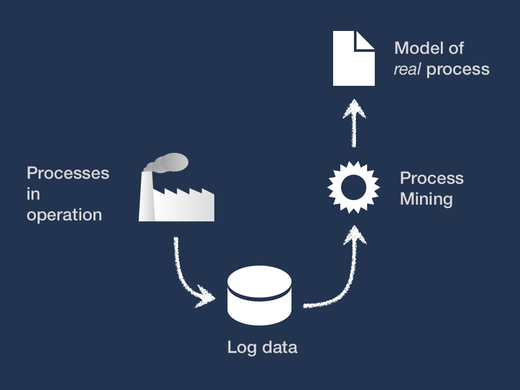
Here is a schematic view that visualizes the way process mining works: The process in operation records data, for example in a data base or a log file. Process mining techniques automatically extract information about the underlying process from these data to provide insight into what actually happened.
12. Raw data cannot be analyzed manually
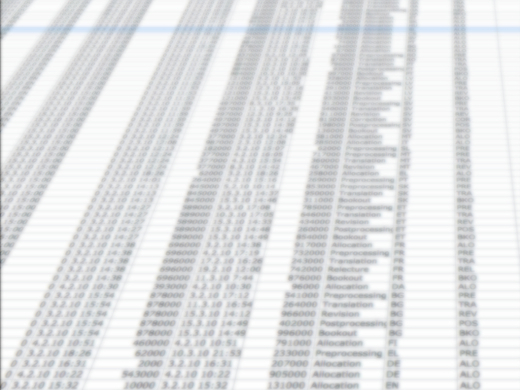
Here you see an example of typical transactional data that are recorded by IT systems. Usually, there are thousands or millions of these kinds of records, which means that it is just impossible to analyze them manually. You can only look at individual cases, but you won’t be able to get a complete overview just by looking at the raw data. Process mining takes all these data records and
13. Process mining transforms these data into process visualizations
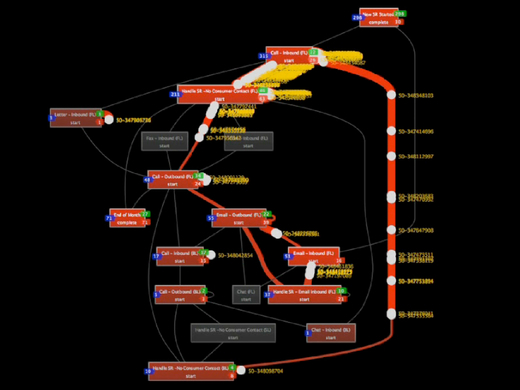
… visualizes the underlying processes. Here you see an example of a callcenter process, which has been reconstructed using process mining. On top of the discovered model, we are replaying and animating the actual behavior. Every white dot is one case, one call center request that moves through the process at the relative speed at which it actually happened in reality.
14. Advantages: objective, quick, and complete

The advantages of process mining are that it’s objective. Because it’s based on data, you don’t need to rely on hearsay. It’s quick because it’s automated, and it can be repeated any time. And complete here means that we look at all the exceptions, all the different variants, which are all in the data even if they just happened once.
15. KPIs can only show that something is wrong
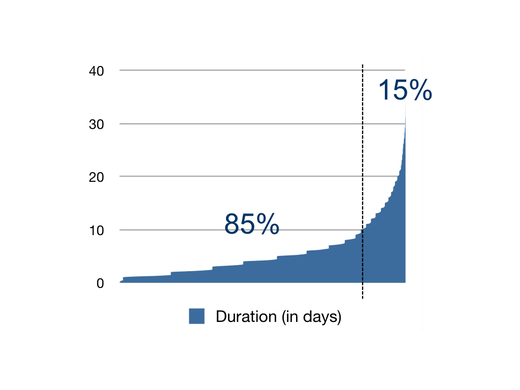
Normally, we look at KPIs to see how a process is doing. Here is one for the throughput time of a repair process. We see that only 85% of all the cases meet the target of a maximum of 10 days in the process completion. 15% are doing bad. But what’s the root cause of this? We don’t know why these 15% are off.
16. Process mining can find the root causes
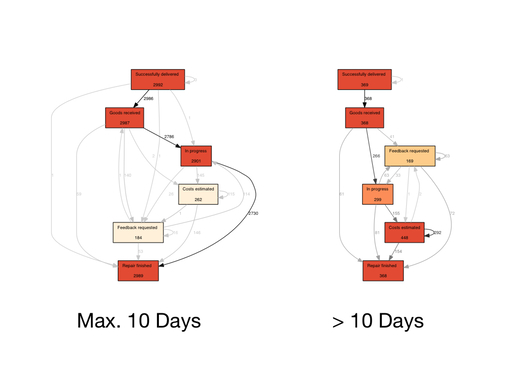
With process mining we can look inside the process, and we can compare: On the left side you see the process flow for the cases that meet the 10-day goal, almost all of them follow the normal path. On the right side you see an increased amount of customer interaction activities, which are the root cause of this delay.
17. KPIs are no more than a fever thermometer – Process mining is like an X-ray

So, KPIs are no more than a fever thermometer – they can tell you that something is wrong. With process mining you can look inside the black box, like an x-ray. This way it is possible to see what the root causes are for problems and inefficiencies in the process.
18. Process mining started in Eindhoven

The technology itself has been invented about 10-12 years ago in the process mining group of Wil van der Aalst at the Eindhoven University of Technology, in the Netherlands. By now the tools and techniques are really mature and have been applied in more than 100 organizations on different scales.
19. Fluxicon: Professional software and services for process mining
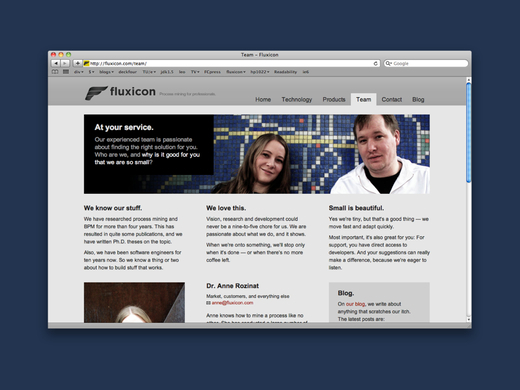
Christian and I have been part of Wil’s process mining group for more than 7 years. We have done our PhD research on process mining, and after that we started Fluxicon as a company for process mining software and services. Our vision is to build professional tools that enable people to re-gain control over their processes in organizations all over the world.
20. Contact us if you want to see a demo!

So, if you have any questions or need help with anything related to process mining, feel free to get in touch – we will help you with that. You can subscribe to our blog, where we publish articles about process mining about once a week. And if you are interested to analyze your own process, contact us to schedule a demo!
I hope you enjoyed the presentation, and thank you for your attention!
-
You can read a summary of the conference here and view the slides of all Pecha Kucha speakers here (in German). ↩︎
Leave a Comment
You must be logged in to post a comment.
